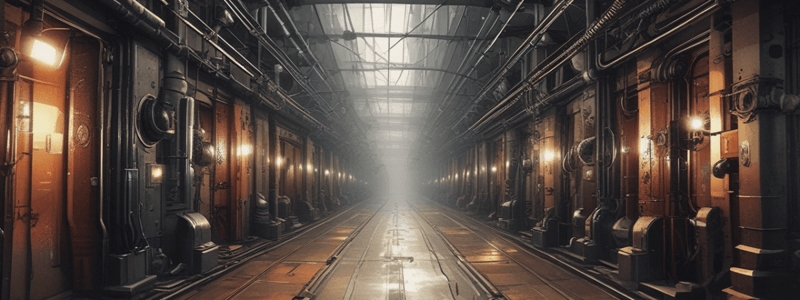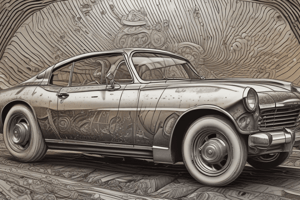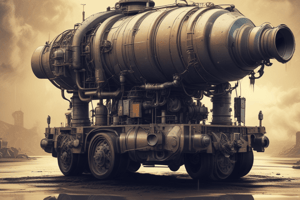Podcast
Questions and Answers
What happens when the piston moves downward in a piston-type compressor?
What happens when the piston moves downward in a piston-type compressor?
- Air is discharged through an exhaust valve
- Air is compressed
- Air is drawn through an intake valve (correct)
- Air is stored in the tank
What is the typical tank pressure range for a single stage piston compressor?
What is the typical tank pressure range for a single stage piston compressor?
- 150-175 psi
- 50-75 psi
- 200-225 psi
- 100-125 psi (correct)
What is an advantage of a two-stage piston compressor over a single stage piston compressor?
What is an advantage of a two-stage piston compressor over a single stage piston compressor?
- Less expensive
- More air can be stored in the same size tank (correct)
- asier maintenance
- Quieter operation
What is a characteristic of rotary screw type compressors compared to piston-type compressors?
What is a characteristic of rotary screw type compressors compared to piston-type compressors?
What is the purpose of the second cylinder in a two-stage piston compressor?
What is the purpose of the second cylinder in a two-stage piston compressor?
How many cylinders are typically used in a single stage - multiple cylinders compressor?
How many cylinders are typically used in a single stage - multiple cylinders compressor?
What happens to the trapped volume of air in a rotary screw type compressor?
What happens to the trapped volume of air in a rotary screw type compressor?
What is an advantage of rotary screw type compressors over piston-type compressors?
What is an advantage of rotary screw type compressors over piston-type compressors?
What is the primary function of a spray booth in spray finishing?
What is the primary function of a spray booth in spray finishing?
What is the typical unit of measurement for air pressure in a compressor?
What is the typical unit of measurement for air pressure in a compressor?
What is the primary factor that determines the amount of water vapor that air can hold?
What is the primary factor that determines the amount of water vapor that air can hold?
What happens to the air in a storage tank when the compressor motor is turned off?
What happens to the air in a storage tank when the compressor motor is turned off?
What is the primary purpose of a respirator in spray finishing?
What is the primary purpose of a respirator in spray finishing?
What is the term for the amount of water vapor in the air?
What is the term for the amount of water vapor in the air?
What is the primary reason why air compressors and air lines are prone to collecting water?
What is the primary reason why air compressors and air lines are prone to collecting water?
What is the term for the rate at which compressed air is delivered?
What is the term for the rate at which compressed air is delivered?
What is the purpose of adding a stream of air to a liquid flow?
What is the purpose of adding a stream of air to a liquid flow?
What are the three main ways to make liquid flow?
What are the three main ways to make liquid flow?
What is a limitation of conventional spray guns with a gravity feed?
What is a limitation of conventional spray guns with a gravity feed?
What is the advantage of using a siphon feed conventional spray gun?
What is the advantage of using a siphon feed conventional spray gun?
What is the function of the fluid needle in a conventional spray gun?
What is the function of the fluid needle in a conventional spray gun?
What determines the shape of the spray pattern in a conventional spray gun?
What determines the shape of the spray pattern in a conventional spray gun?
Why are the air cap, fluid tip, and fluid needle typically a matched set?
Why are the air cap, fluid tip, and fluid needle typically a matched set?
What is the disadvantage of using a conventional spray gun with a siphon feed in tight spaces?
What is the disadvantage of using a conventional spray gun with a siphon feed in tight spaces?
What is the primary advantage of the Pressure Pot System?
What is the primary advantage of the Pressure Pot System?
What is the purpose of the two regulators on most Pressure Pot System tanks?
What is the purpose of the two regulators on most Pressure Pot System tanks?
What type of materials can be used with the Pressure Pot System?
What type of materials can be used with the Pressure Pot System?
What is the significance of the pressure rating of the Pressure Pot System tank?
What is the significance of the pressure rating of the Pressure Pot System tank?
What is the primary difference between HVLP guns and conventional spray guns?
What is the primary difference between HVLP guns and conventional spray guns?
How does the HVLP Turbine System generate the required airflow?
How does the HVLP Turbine System generate the required airflow?
What is the characteristic of the air pressure in the HVLP Turbine System?
What is the characteristic of the air pressure in the HVLP Turbine System?
What is a limitation of the Pressure Pot System?
What is a limitation of the Pressure Pot System?
What is the primary reason for rotating the air cap 180 degrees to assess a defect?
What is the primary reason for rotating the air cap 180 degrees to assess a defect?
What is the result of moving a gun in a non-parallel manner to the workpiece?
What is the result of moving a gun in a non-parallel manner to the workpiece?
What is the primary purpose of a vent hole in a conventional spray gun's cup lid?
What is the primary purpose of a vent hole in a conventional spray gun's cup lid?
What is the primary benefit of using a respirator in a hazardous environment?
What is the primary benefit of using a respirator in a hazardous environment?
What is a characteristic of negative pressure respiratory equipment?
What is a characteristic of negative pressure respiratory equipment?
What is the primary difference between positive pressure and negative pressure respiratory equipment?
What is the primary difference between positive pressure and negative pressure respiratory equipment?
What is an advantage of powered air positive pressure respiratory equipment?
What is an advantage of powered air positive pressure respiratory equipment?
What is the primary characteristic of Self Contained Breathing Apparatus (SCBA)?
What is the primary characteristic of Self Contained Breathing Apparatus (SCBA)?
Flashcards are hidden until you start studying
Study Notes
Spray Finishing and Touch-Ups
- Overview of Spray Finishing: Equipment, materials, and techniques
- Two parts: Theory and Practical
Theory Topics
- Air Compressors
- A supply of clean, dry air is required for many shop equipment
- Type and size of compressor depend on selected spray equipment
Air Compressors
- A device that uses a motor/air pump to force air into a storage tank
- Compressed air is held in the tank until used
- When tank pressure reaches upper pressure limit, the motor shuts off
- When tank pressure drops, the motor turns back on
Compressed Air/Compressor Properties
- Pressure: Typically stated in pounds per square inch (psi)
- Delivery Rate (Flow Rate): Typically stated in cubic feet per minute (CFM) at a specific pressure
- Storage Volume: Typically stated in gallons or liters
Humidity
- Air can hold water vapor (moisture)
- Humidity: The amount of water vapor in the air
- Maximum amount of water vapor depends on the temperature and air pressure of the air
- Condensation occurs when air temperature drops
Compressors and Water
- When air is compressed, pressure increases, and water vapor condenses
- When air is released from the storage tank, air expands, and water temperature drops, forming condensation in air lines
- Compressor tanks and air lines collect water depending on the relative humidity
Types of Air Compressors
- Piston Type
- Creates air pressure through the action of a reciprocating piston
- Single Stage Piston
- Air is drawn from the atmosphere and compressed to final pressure with a single stroke
- Tank pressure typically kept between 100 psi and 125 psi
- Two Stage Piston
- Two cylinders: one large and one small
- Air compressed in two separate steps
- Higher pressure and more air can be stored in the same size tank
- Advantage: More air can be stored; Disadvantage: Cost
- Rotary Screw Type
- Utilizes two intermeshing helical rotors in a twin bore case
- Air is compressed between one convex and one concave rotor
- Trapped volume of air is decreased, and pressure increases
- Quieter, higher CFM, and faster fill/recharge times
Making Liquid Flow
- Gravity
- Suction
- Pressurized Container (e.g., super soaker water gun)
- Pump
Spray Systems
- Types of Spray Systems
- Conventional Spray Guns
- Gravity Feed
- Material is fed from a container above the gun via gravity
- Liquid is atomized with compressed air
- Pros: Well-suited for spraying both thin and thicker materials, relatively quick cleanup
- Cons: Cumbersome in tight spaces, top-heavy, must be held upright
- Siphon (Suction) Feed
- Material is fed from a container below the gun via vacuum or suction
- Liquid is atomized with compressed air
- Pros: Well-suited for spraying thinner materials, relatively quick cleanup
- Cons: Cumbersome in tight spaces, uses more compressed air, small capacity
- Gravity Feed
- Pressure Pot System
- Gun + separate storage container for material
- Liquid is atomized with compressed air
- Pros: Gun is light, can be used in more confined areas, various container sizes
- Cons: Care should be taken not to exceed the recommended pressure rating of the tank, long change over due to amount of cleaning needed
- HVLP Turbine System
- ‘HVLP’ – High Volume Low Pressure
- Pressure is less than 10 psi
- HVLP Gun + Electric Turbine
- Turbine generates the required airflow
- Air travels through a series of fans, each fan stage boosts the air pressure
- HVLP Guns: Have larger passageways, available as siphon feed or gravity feed
- Conventional Spray Guns
Troubleshooting
- Blockage or debris on the fluid tip/needle
- Rotate air cap 180 degrees to assess
- Clean vent hole to resolve pulsating/fluttering issue
Respirators
- Can help protect against particulate hazards and chemical gases
- Selection of respirator type based on the type of hazard and level of exposure
- Respiratory Equipment Types
- Negative Pressure
- Relies on the wearer's lungs to pull air through the cartridge or filter
- Potential to put strain on the wearer
- Tight-fitting, requires fit testing and seal checks before use
- Positive Pressure
- Equipment pushes air to the hood or facepiece
- Powered Air (battery-powered blower) or Supplied Air (bringing in clean air from outside the contaminated area)
- May be loose-fitting or tight-fitting, facial hair compatible
- SCBA (Self-Contained Breathing Apparatus)
- User carries the source of clean air with them in a tank
- Negative Pressure
Studying That Suits You
Use AI to generate personalized quizzes and flashcards to suit your learning preferences.



